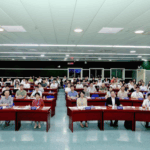This morning, the municipal government’s information office held the ninth press conference in the “Drawing the Blueprint Through Practical Work” series on Shanghai’s 14th Five-Year Plan achievements, focusing on the theme of “The ‘New’ in Modern New Cities.” The Jiading District Party Committee Secretary introduced the district’s development achievements during the 14th Five-Year Plan period. Other district leaders and department heads jointly attended the press conference and answered questions.
Jiading is Shanghai’s northwest gateway, the new city closest to the central urban area, and a renowned smart automotive city. It serves as an important hub for Shanghai’s international science and technology innovation center and the core area of the Hongqiao International Open Hub, boasting significant geographical advantages, strong innovation momentum, solid industrial foundation, rich cultural heritage, and beautiful ecological environment. Since the start of the 14th Five-Year Plan period, under strong leadership, Jiading has focused on accelerating the construction of a modern new city characterized by “abundant innovation vitality, full integrated development, rich cultural charm, and prosperous living standards.” The district has seized opportunities, forged ahead, worked practically, and taken the lead, striving to become a benchmark for high-quality development while rapidly enhancing its urban capabilities and core competitiveness. It has successfully reached three “300 billion yuan” milestones: First, the regional GDP exceeded 300 billion yuan in 2024, with GDP per unit of construction land increasing by 20 percentage points compared to the end of the 13th Five-Year Plan period. Second, fixed asset investments during the 14th Five-Year Plan period accumulated over 300 billion yuan, surpassing the 250 billion yuan target. Third, the automotive industry’s scale and level further climbed, with automotive industrial output value crossing the 300 billion yuan threshold. Looking back at the 14th Five-Year Plan period, regional development achieved what can be summarized as “Four Ji Speeds”:
First: Adhering to Innovation-Driven Development, Achieving “Ji Speed” in Building New Advantages for Modern Industries
Comprehensive efforts were made to promote quality, efficiency, and dynamic reforms, developing new productive forces according to local conditions, thereby strengthening the foundation and improving the quality of high-quality development.
First, new industrial momentum and advantages were rapidly shaped. Emerging industries accelerated their growth. The three trillion-yuan industries—automotive “new four modernizations,” integrated circuits, and biomedicine—showed strong growth, with an average annual growth rate of 13.8%, reaching a total output of 360.3 billion yuan last year. The proportion of strategic emerging industries in industrial output value increased by 13.4 percentage points compared to the end of the 13th Five-Year Plan period. Traditional industries were upgraded and revitalized. Over the past four years, 619 hectares of inefficient construction land were reduced. The district pioneered citywide comprehensive assessments of智能制造 capability maturity for规上 enterprises, cultivated 103 smart factories at various levels, and two enterprises were recognized as national “卓越级” smart factories. Future industries were strategically positioned. Seizing new opportunities and emerging sectors, industries such as low-altitude economy, embodied intelligence, and future energy accelerated their development.
Second, the concentration and visibility of scientific and technological innovation became more prominent. Focused efforts were made to advance the construction of the science and technology innovation center’s important hub, enhancing innovation vitality and momentum. R&D expenditure as a percentage of added value reached 6.22%, maintaining a leading position in the city. The district gathered 2,578 high-tech enterprises, 309 municipal科技小巨人 (cultivation) enterprises, 1,343 specialized and sophisticated SMEs, and 36 A-share listed enterprises, ranking third in the city. Two trillion-yuan科技园总体规划 for university-local and institute-local cooperation were formulated and implemented, attracting 1,750 cooperative enterprises. Technology contract transaction value exceeded 122 billion yuan, with high-value invention patents per 10,000 people reaching 47.54. Technology transaction value at the Yangtze River Delta Science and Technology Fair doubled. The district established a science and technology investment group, leveraging the formation of a trillion-yuan scale fund ecosystem. Six top-tier talents and 406 overseas high-level innovation and entrepreneurship talents were introduced, with the total talent pool approaching 400,000.
Second: Adhering to Strategic Leadership, Achieving “Ji Speed” in Building a New Modern Urban Pattern
Major strategic opportunities were seized to promote integrated industry-city development and coordinated urban-rural development, accelerating the improvement of urban functions and quality.
The functional and visual aspects of the three demonstration zones—Yuanxiang Lake Central Activity Zone, Jiabao Smart Bay, and Ximen Historical and Cultural Block—were increasingly refined. 265 major projects were comprehensively advanced, and 21 city-level major functional projects, including SA
Shanghai
Jiading District
Hongqiao International Open Hub
Yuanxiang Lake Central Activity Zone
Jiabao Smart Bay
Ximen Historical and Cultural Block
Yangtze River Delta Science and Technology Fair
SA
If you can provide the full name of the place, I would be happy to write a summary for you.



